
Features
Training
Back to Basics: August 2012
Different-sized hoselines can be used as offensive weapons or defensive tools to suppress fire.
August 2, 2012
By Mark van der Feyst
Different-sized hoselines can be used as offensive weapons or defensive tools to suppress fire. The most commonly used hoselines are one-and-a-half-inch, one-and-thee-quarter-inch and two-and-a-half-inch, each flowing a different rate of water and producing different nozzle reactions.
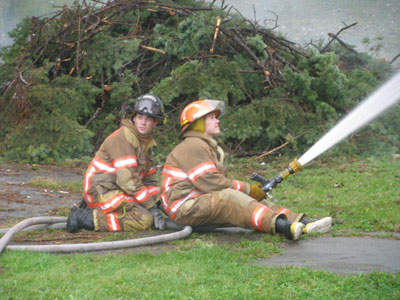 |
|
| Photo 1: The firefighter in the orange helmet controls the hoseline by turning it into a circle and passing it under itself, then sitting on the crossed section. |
|
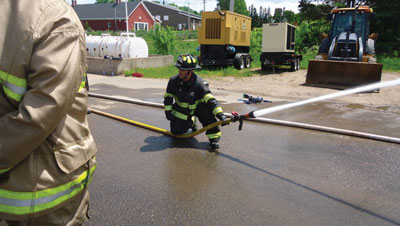 |
|
| Photo 2: The firefighter kneels on the hoseline, using his body weight to hold the line in place. |
|
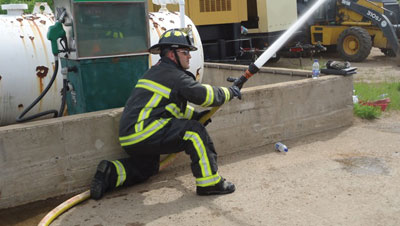 |
|
| Photo 3: Inside the structure, a firefighter can use his knee to push the hoseline into the corner of the baseboard and floor, further securing the line. |
|
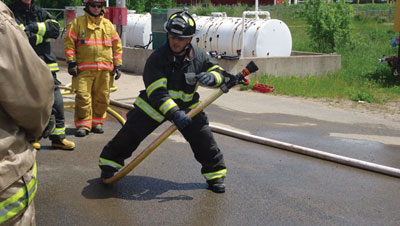 |
|
| Photo 4: This method can also be performed in a standing position, allowing the firefighter to direct the stream through doorways and across hallways. |
|
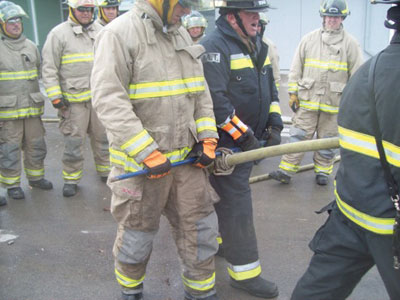 |
|
| Photo 5: A pry bar secured with rope forms a T-handle, allowing two firefighters to stand side by side, while a third firefighter directs the nozzle. |
|
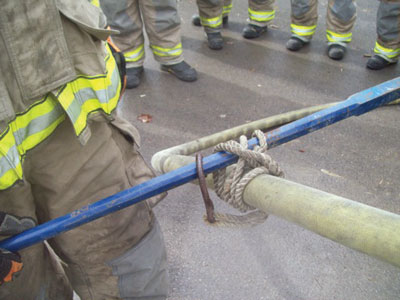 |
|
| Photo 6: The rope is tied in a criss-cross pattern to secure the pry bar to the hoseline. |
|
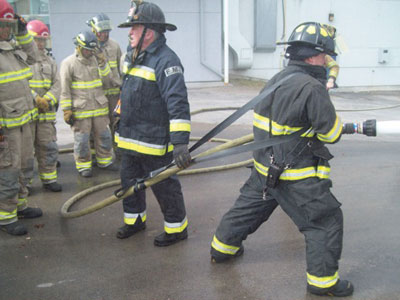 |
|
| Photo 7: A firefighter uses a webbing strap around his shoulder to hold the hoseline. The strap is long enough to allow the hose to rise to the shoulder at a gentle angle, and is on the outside of the firefighter’s body, allowing for an easy release. |
|
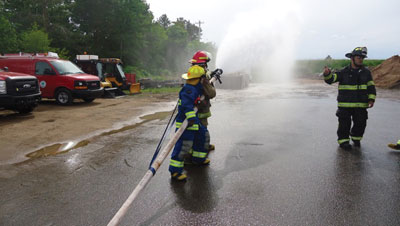 |
|
| Photo 8: Each firefighter manning the hoseline will require his or her own webbing strap. Photos by Mark van der Feyst |
As few as one firefighter, or as many as four firefighters can be needed to hold the line, depending on the diametre of the line, the amount of water flowing and the required pressure being pumped from the apparatus. Many firefighters fatigue quickly when manning a hoseline and then have a hard time trying to maintain control. There are different ways to hold the line.
The sitting method is the most common way for a single firefighter to hold the line. The firefighter turns the hose into a circular shape and then passes it underneath itself, so that he or she is able to sit on the hose at the point at which the two sections are in contact with each other. As shown in photo 1, the firefighter in the orange helmet is sitting on the two sections, and controlling the hoseline. Although this method allows just one firefighter to manage a small-diameter or a large-diameter hoseline, it is not very ergonomic; lower-back fatigue sets in quickly while reaching/hunching forward to hold the nozzle and control it. This method works well only for defensive positions.
Another way for a single firefighter to manage a hoseline is to kneel on it. This method allows one firefighter to control the hoseline while a partner is away momentarily conducting other tasks if on interior assignment. Kneeling uses the firefighter’s body weight to hold the line in place while delivering water. This nozzle reaction is directed toward the ground, with the knee resting on the hose, as seen in photo 2. On the inside of a structure, the corner of the baseboard and the floor area can be used to push the hoseline into with the knee holding it in position, as seen in photo 3. The foot can also be used in a standing position for interior attack, as seen in photo 4. This allows a firefighter to direct the stream of water through doorways of rooms across the hallway when trying to control the fire. The second firefighter may be away pulling in more hose or searching a nearby room. With the other team member committed to his or her duties, the nozzle firefighter can still be effective by holding the line in place using body weight, and applying water at full pressure and flow.
For larger-diameter hoselines, a pry bar along with rope or webbing can be used to construct a T-handle for the hoseline, as seen in photo 5. Using this T-handle allows two firefighters to stand side by side to hold the line while a third firefighter controls and direct the nozzle. As shown in photo 6, the rope or webbing used to secure the pry bar to the hose is wrapped around in a criss-cross fashion. The T-handle allows the firefighter team to stand or kneel while holding the line, and advance the line in unison. The T-handle is far enough back from the nozzle to give the firefighter manning the nozzle enough room to control and direct it without any interference. This method is primarily used for defensive positions or for large interior operations such as a commercial warehouse or big-box store.
Webbing is a great aid for holding the line. The firefighter in photo 7 is holding the hoseline with a webbing strap around his shoulder. The webbing strap should be long enough to allow the firefighter to produce a gentle angle from where the girth hitch is created up to the shoulder. If the angle is too sharp, the firefighter will feel himself being pulled down because of the nozzle reaction. Webbing should be between 10 and 15 feet long and it needs to be a closed loop; this can be accomplished by tying a water knot at the end. The webbing is tied in a girth-hitch fashion, which means simply passing the webbing through itself and tightening it. A girth hitch is not recommended for any life-safety application but will suffice for holding a hoseline.
Notice how the firefighter in photo 7 has the webbing strap around his outside shoulder. This allows the firefighter to quickly drop the hoseline and walk away should the need arise; the firefighter simply turns to the right and the webbing strap falls off with no entanglements. Having the webbing on the outside shoulder allows the firefighter to face the hose, and, therefore, better oppose the nozzle reaction. If the webbing is on the inside shoulder, the nozzle reaction forces the firefighter to stand square with the hose, putting him in an awkward position.
If two or three firefighters are being deployed, then two webbing straps can be used, leaving one firefighter to control and direct the nozzle, as seen in photo 8. This method works well for defensive positions.
Mark van der Feyst is a 13-year veteran of the fire service and works for the City of Woodstock Fire Department in Ontario. Mark is an international instructor, teaching in Canada, the United States and India. He is a local level suppression instructor for the Pennsylvania State Fire Academy and an instructor for the Justice Institute of B.C. Contact him at Mark@FireStarTraining.com
Print this page